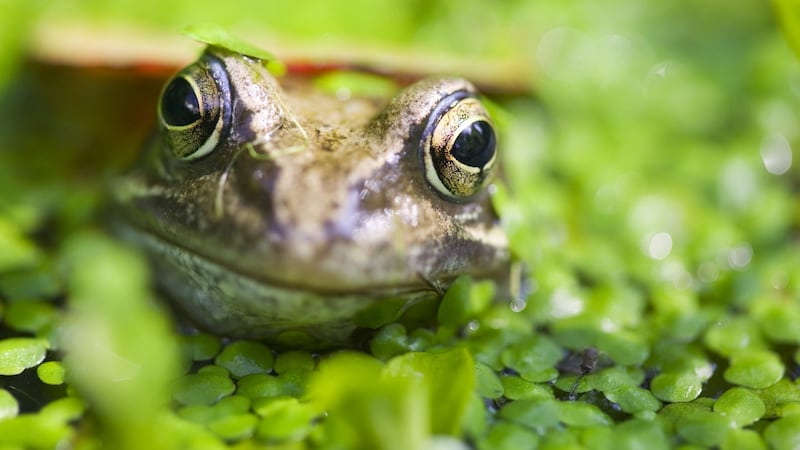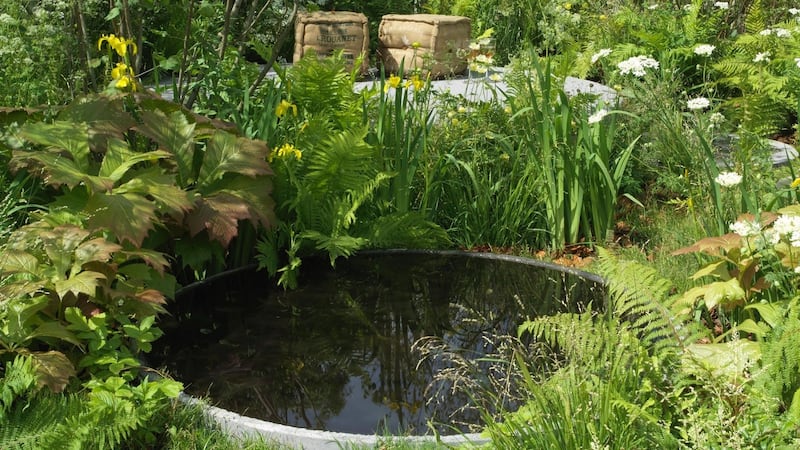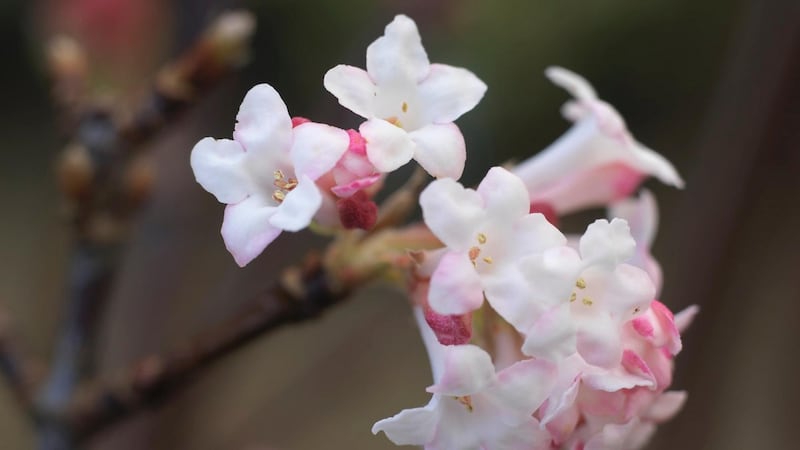A Cork reader asks for advice on how to give her garden pond a makeover:
“Help! While our small garden pond has given us immense pleasure over the years, it’s gradually become so choked-up with overgrown plants, mud and algae that we can’t even see the water anymore. Any tips on how to get it ship-shape again?”
While a well-kept garden pond is a thing of great beauty and never-ending fascination, a neglected one can feel like a guilt-inducing reproach. The truth is that even the loveliest needs some tough love every 5-10 years if it is to stay free of encroaching weeds, overabundant growth, algae and the sort of accumulated silt that will gradually transform it into what could more accurately be described as a bog garden.
How to start? While it’s a wet and mucky job, the good news is that unless the weather is very cold, late autumn/early winter is a good time to carry out a major overhaul as the many creatures that depend upon it as a valuable habitat are less active.
If your pond is home to any fish, the first step is to prepare a holding tank/large waterproof container to temporarily house them (place this in a shady spot nearby and fill it with some of the existing pond water).
Also use this to temporarily store what are known as deep-water plants, whose root systems grow at the base of a pond, or on its deeper shelves, but whose foliage is on/above the water surface. Examples include water lilies, water hawthorn/Aponogeton distachyos and golden club/Orontium aquaticum.
If your pond uses an electric pump, then unplug this before gently removing it from the water and setting it aside for cleaning/servicing. Next, start to gently remove any remaining plants/debris, placing these nearby so that any aquatic life–the countless different tiny mini-beasts that call your pond home, including water boatmen, snails, beetles, pond skaters and frogs–can eventually find their way back to it.
Then drain off the remaining water (you can hire what is known as a clean-out pump to do this but a bucket will often suffice) before gently removing any remaining silt or debris from the base. At this point in the proceedings, take extra care not to accidentally puncture/damage the waterproof pond liner.
Holes and puncture marks
Once the pond is completely empty, gently hose the surface down before examining the exposed liner for any holes/puncture marks. If you find any, the liner will need to be either repaired (there are puncture kits designed specifically for this purpose) or replaced, ideally using a high quality flexible rubber liner such as butyl or EPDM laid over a generous layer of underlay. But if it’s puncture-free, then simply replace a small amount of the excavated mud/silt at the base of the emptied pond before replacing the pump (make sure this is clean and in good working order), and slowly refilling the pond with water (harvested rainwater is best), replanting each level as you do so.

Bear in mind that pond plants are typically divided into four rough categories: marginal and marsh plants that grow around its shallow edges (examples include marsh marigolds/Caltha, varieties of Iris laevigata, purple-loosestrife/ Lythrum and the evergreen Acorus 'Ogon' ; oxygenating plants that grow beneath the surface of the water (examples include starwort/Callitriche, hornwort /Ceratophyllum and spiked water milfoil/Myriophyllum; surface floating plants without conventional root systems (examples include frogbit/Hydrocharis and star duckweed/Lemna); and last but not least, deep-water plants as described earlier.
Each kind performs an important role within a wildlife-friendly pond's delicate ecosystem and are widely available from good garden centres as well as from specialist nurseries such as Roscommon-based Irish Water Plants. The best time to buy these is between mid-spring and early summer.
Return the fish
Finish off your garden pond makeover by gently returning any fish to it. To acclimatise these to the new water, it’s recommended that you place them in plastic bags filled with the original pond water and float these on the surface of the newly-filled pond for half an hour or so, gradually adding small amounts of the new water to the bags before releasing them. Don’t forget to throw a few tennis balls into the water to stop ice forming on the surface over the winter. Finally, bear in mind that while this sort of major pond overhaul is necessary occasionally, it will inevitably disrupt your pond’s fragile ecosystem with the result that it can take it up to a year to recover its equilibrium. In the meantime, make sure to keep it free of fallen leaves and other garden debris.

It is worth adding that there is increasing interest in what are sometimes called “natural ponds”, which are designed to function quite happily without the use of electric pumps, filters or the chemicals that some gardeners resort to, relying instead on clever design and the pond’s natural ecosystem of interacting organisms to establish a happy balance.
One of the proponents of this kind of eco-friendly garden pond is the American scientist and pondaholic Robert Pavlis. His recent book on the subject, Building Natural Ponds (New Society Publishers), explains how to design a garden pond to create a self-sufficient ecosystem akin to what you'd find in the wild, using a variety of different plants (plus some fish) to feed on decaying organic matter, absorb excess nutrients, and shade out light to inhibit the growth of algae. His argument – a convincing one – is that if nature can do it, then why can't we?

This Week in the Garden
If you’re longing for the taste of some fresh, homegrown food, try sowing seeds of micro-leaves/micro-greens indoors, using a couple of compost-filled pots placed on a bright window sill in a warm room. These tiny edible seedlings pack a powerful culinary punch in terms of colour, texture and flavour and can be typically harvested within a few weeks of germination. Leafy plants suitable for growing as micro-leaves include culinary herbs such as coriander, chervil, dill, basil, fenugreek, sorrel and mint and many popular vegetables including beetroot, chard, kale, rocket, peas, broccoli as well as oriental salad leaves such as mizuna, mibuna and komatsuna.
Sowing micro-leaves at this time of the year is a great way to use up old seed packets nearing their expiry date but you can also buy special micro-green mixes from good Irish garden centres as well as from online Irish suppliers such as seedaholic.com and greenvegetableseeds.com.
Late November/early December is the perfect time to plant grape vines. Depending on the variety chosen, these can be grown under the cover of a conservatory, even in a large pot or outdoors in the garden. Grape vines need a very fertile, free draining soil enriched with homemade garden compost or well-rotted manure.

Their root systems also need a period of winter chilling so conservatory/polytunnel grown plants should be planted with their root systems just outside the structure while container grown grape vines should be moved outdoors at this time of the year before being brought back under cover in spring. Now is also the best time to prune established vines. See rhs.org.uk for recommended pruning techniques.
If you're looking for a tough, reliable, hardy shrub to add some winter scent and sparkle to your garden, the Viburnum bodnantense is one of the best. In mild winters, it will keep flowering until March, making it one of the most useful plants for the winter garden. Varieties commonly available in good Irish garden centres include the free-flowering Charles Lamont (3m x 2m) and Dawn. Late November is also a good time to plant this deciduous shrub. Give it a moist, fertile but well-drained soil in full sun or light shade, ideally in a sheltered position close to a path/doorway where the perfume of its clusters of pink flowers can be properly appreciated.

Dates For Your Diary
Saturday 25th November, 3pm: as part of Dublin Gallery Weekend and the Graphic Studio's ongoing exhibition of garden-inspired art, 'Another Bite of the Cherry' at the National Botanic Gardens visitor centre, Glasnevin, Dublin 9, artist Jennifer Lane will be giving a practical demonstration of the age-old method of handprinting original woodcut prints on a miniature press; Tuesday 28th November (8pm), Foxrock Parish Pastoral Centre,18 Kill Lane, Dublin 18, 'Climbers and Wall Shrubs' , a talk by horticulturist Frances MacDonald of the Bay Garden on behalf of Foxrock and District Gardening Club; Thursday 30th November (8pm), The Artane Beaumont Family Recreation Centre, Kilmore Road, Dublin 5, 'The Flower Arranger's Garden' a talk by horticulturist Chris Heavey on behalf of Dublin 5, Horticultural Society, admission €5.














